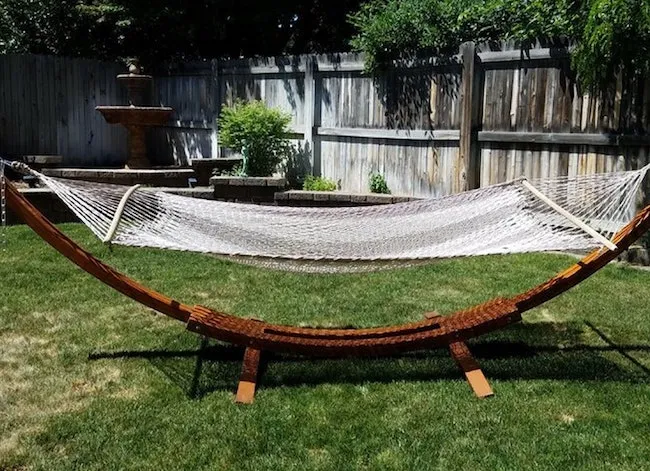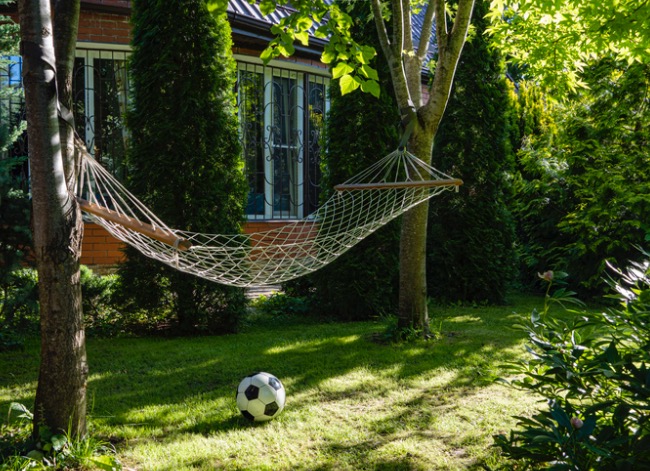We may earn revenue from the products available on this page and participate in affiliate programs. Learn More ›
A DIY hammock is a game-changer for your outdoor space. What else says summer like a homemade hammock gently swaying in the afternoon breeze? If you do not love the styles—or the prices—of the hammocks you’ve seen for sale in stores, or if you’re looking for a productive way to earn your nap time, consider getting this season into full swing by constructing your own DIY hammock. Scroll down to check out 12 inviting designs, each one easy to achieve with a set of basic tools and only a small quantity of readily available materials.
What to Consider Before You Make a Hammock
Before you break out the tools and acquire the materials to make a hammock, there’s a little preliminary work you need to do first. A homemade hammock can be small to fit a single person or larger for multiple people. Whether you’re hanging the hammock from a tree, porch ceiling, or building beams, you need to know that the weight of your DIY hammock and its occupants are supported.
When hanging a hammock, you need the distance between these supports to be at least the length of the hammock, and longer if you want more tension. The ideal height for your hammock is about 18 inches, making it easier to sit in your hammock, and less distance to the ground if you happen to fall out.
Finally, decide on the materials you’ll use to make your hammock. Hammocks can be made from a variety of materials, each with its own pros and cons. For example:
- Cotton, though cozy and breathable, absorbs more moisture and doesn’t dry quickly.
- Polyester is durable and weather resistant.
- Nylon is extremely lightweight, portable, and quick-drying, but less supportive.
- Rope hammocks may be unsafe for children, who may get caught in the holes.
Do your homework to figure out which hammock ideas, materials, and designs are most practical for your needs. Here are some of our favorite DIY hammock ideas:

1. Drop Zone
We normally think of drop cloths as hardworking, durable, and unabashedly simple. As it turns out, those same qualities make a drop cloth perfect for reuse in a DIY hammock. Visit My Repurposed Life to see how to make a hammock using a 6-foot by 9-foot sheet of canvas along with grommets and rope.

2. Sail Away
To put a modern spin on the classic hammock design, opt to use rope in two colors to make a DIY rope hammock. A list of the needed supplies can be found over at Design Milk, along with detailed instructions. We think that when it comes to de-stressing, the process of weaving a homemade hammock actually rivals the simple pleasure of lying on one.
3. Float On
From Camille Styles, here’s a romantically ethereal DIY hammock comprising a combination of airy, breathable muslin and sturdy canvas. Clothesline and simple chains do the work of suspending the homemade hammock from adjacent trees, but it can be made even more elegant with optional lace or fringe embellishments.
4. Here’s a Hammock Idea: Rip It
Ripstop nylon shows up in pants, parachutes, and a variety of other everyday applications. Light as a feather yet strong as a bull, it’s ideal stuff from which to craft a DIY hammock. To re-create this one, drop by Ripstop for details on sewing together sections of nylon and forming the channels for the twin suspension cords.
5. Beckon the Beach
Comfortable and completely customizable, this creative DIY hammock ingeniously incorporates a bright beach towel made of plush cotton. To make a DIY hammock like this, the first step is to choose an oversize towel (at least 40 inches by 80 inches) in your favorite summery color or pattern. Then head on over to Design Sponge to get the project tutorial.
6. DIY Hammock Bedsheet
When you replace your linens, upcycle old queen or king-size bed sheets into a soft and cozy hammock. You don’t have to be an expert seamstress to fold and stitch together this fabric hammock. Follow the three-step instructions by My Silly Squirts, and in about an hour you’ll be hanging your new DIY hammock bed sheet in the backyard.

7. Backyard Bohemian Homemade Hammock
Macramé is for more than plant hangers. Dive deep into this craft project and the end result is a beautiful, patterned DIY hammock that you create with your own skilled hands. Using about 1,000 yards of cord in your chosen colors, two sturdy metal rings, two wooden dowels, and some easy-to-learn macramé knots, the end result is a gorgeous vintage-inspired hammock. Olga’s Macramé hobby site walks you through how it’s done.
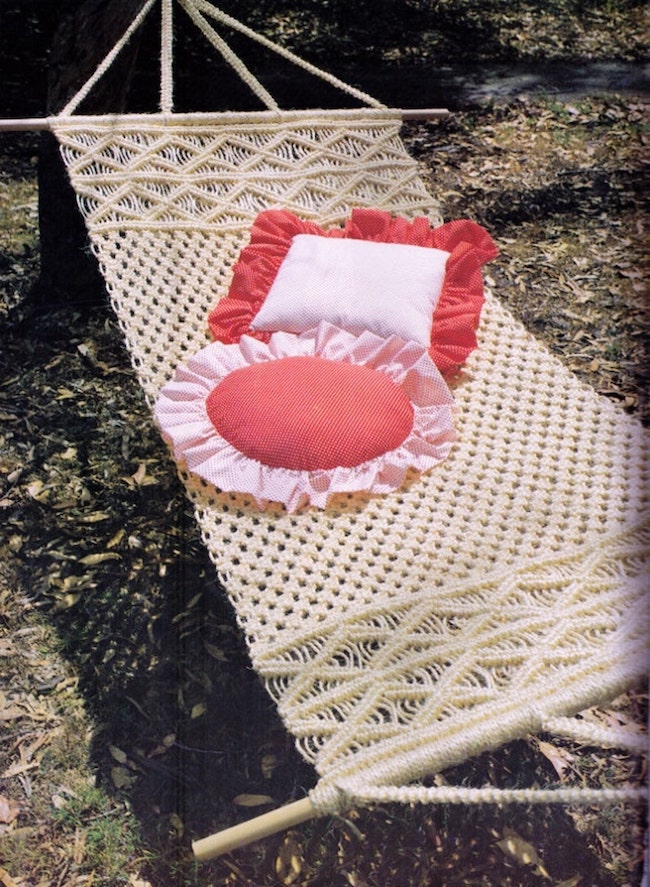
8. Jump Into a DIY Hammock Swing
If your trampoline is ready for its second act, turn it into a comfy indoor or outdoor hammock swing, like this one on Steemit. This family-size hammock can use a woven rope base, or DIYers can make a custom foam mattress to make the swing feel more like a bed. With the immense size of trampolines, having an extra set of hands to help hang your DIY hammock swing will make it much easier and safer.
9. From Protection to Relaxation
Tarps are wonderfully helpful, especially when camping. As practical as they are, these super tough, protective sheets can also be used to create a makeshift hammock. Perhaps less permanent and less aesthetically pleasing than other DIY hammock ideas, a tarp surely does the job of helping you relax. Using only a tarp, two C-clamps, and 25 to 30 inches of paracord, this Instructables tutorial shows you how to make a rudimentary tarp in mere minutes.
10. I Kid You Knot
Simple and welcoming, a classic DIY rope hammock fits into just about any backyard. Using about 300 meters of comfortable cotton rope or weather-resistant polypropylene multicord, your summer hammock can be assembled in just a few short hours. Get the full tutorial on Ropes Direct, and learn how to make a hammock with rope, stainless steel fittings, and wooden dowels.
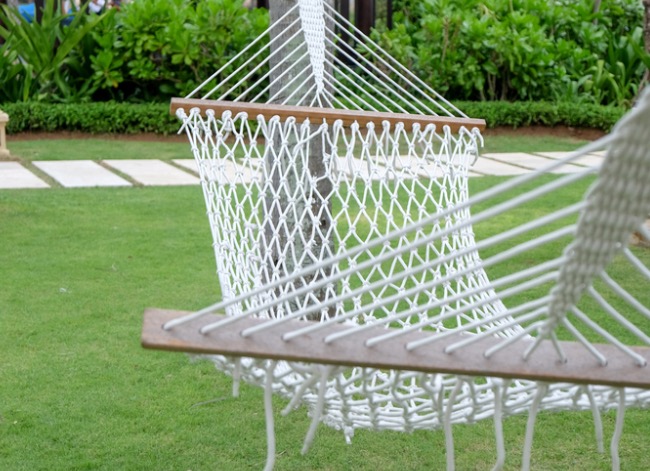
11. Double Up on Layers
When it comes to napping or overnight sleeping in a hammock, some designs are less than ideal. A double-layer DIY hammock allows you to sandwich a sleeping pad between the layers for comfort and added insulation. A more durable, water-resistant fabric is better suited for this style, as it will keep the interior drier, helping prevent mold and mildew from forming. Big White Fish does a great job explaining how to sew the layers together for a comfortable rest.
12. Make a Hammock Chair
Hammocks aren’t just for reclining beneath the shade of trees. A Beautiful Mess does a fantastic job of explaining the steps needed to create an aesthetically pleasing canvas hammock chair that works either inside or outside. Using a strong oak dowel, braided polypropylene, canvas, and stainless steel links, you can create a cozy reading or relaxing chair. Further customize this design with fabric paints and imagination.
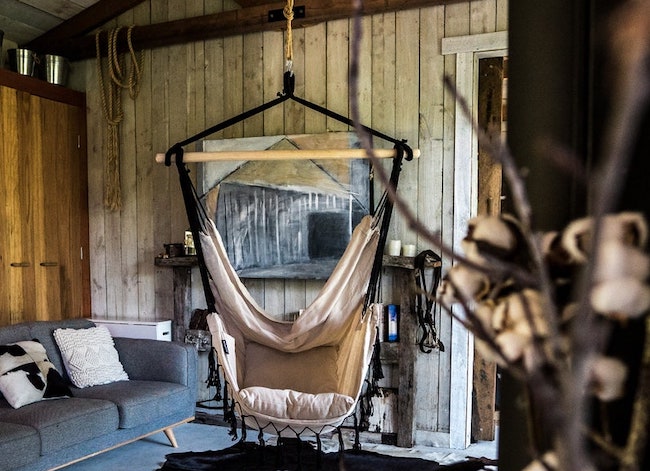
Also Consider: Hammock Stands
No support structures around? No problem. A DIY hammock stand is another project you can add to your to-do list. A hammock stand eliminates the need to have anchor points for your homemade hammock.
These handy stands don’t rely on tying a perfect knot to a tree and they’re entirely mobile, so you can set them up wherever you like. Stands can be used for many types of hammocks: indoor, outdoor, with or without spreader bars. These stands come in various sizes, so ensure you get one that fits your hammock or build a hammock that fits the stand.
Backyard hammock stands are usually made of wood, steel, or bamboo, and they’re designed to withstand moisture and inclement weather, but they can be used indoors, too. Portable hammock stands are lightweight, usually made from wood, fiberglass, or even PVC pipes, for use in the backyard, in the home, or when camping.
